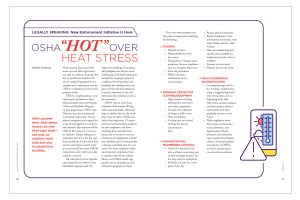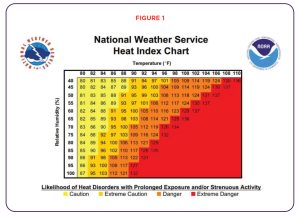LEGALLY SPEAKING: New Enforcement Initiative Is Here—OSHA “Hot” Over Heat Stress
With summer here, heat stress issues can rear their ugly head—not only on outdoor work sites but also in production facilities. Do not be caught ill prepared for an incident and a subsequent visit by OSHA—establish your heat stress program today.
OSHA is implementing a new enforcement initiative on heat-related hazards and is developing a National Emphasis Program on heat inspections. OSHA Area Directors have been instructed to prioritize inspections of heat-related complaints and expand the scope of investigations to look for heat hazards. This summer will be OSHA’s first season to carry out its initiative. Simply telling your employees that it is a hot day and they should take breaks when they need to and drink as much water as necessary will not meet OSHA’s expectations and could very easily result in a citation.
The risk of heat stress depends upon many factors related to the individual employee, and this makes the challenge of creating a safe workplace for all even more challenging. Individual risk factors include the employee’s physical condition, the temperature and humidity, the clothing worn, the pace of work and how strenuous it may be, exposure to sun, and environmental conditions such as air movement.
OSHA expects more from employers than merely offering water, rest, and shade; additional steps to address heat in the workplace must be taken. OSHA also insists that employers: (1) implement an “acclimatization program” for new employees and those returning from extended time away, such as vacations or leaves of absence; (2) implement a work/rest schedule; and (3) even provide a climate-controlled area for cool down. For those employers utilizing temporary employees, there is a greater risk of heat-related illness, and OSHA would urge greater care in adopting an acclimatization program for them.
Your heat stress program can have many components, including the following.
TRAINING
- Hazards of stress
- Responsibility to avoid heat stress
- Recognition of danger signs/symptoms (because employees may not recognize their own)
- First-aid procedures
- Effects of certain medications in hot environments
PERSONAL PROTECTIVE CLOTHING/EQUIPMENT
- Light summer clothing allowing free movement and sweat evaporation
- Loosely worn reflective clothing to deflect heat
- Hats and helmets
- Cooling vest and wetted clothing for special circumstances
- Fans
ADMINISTRATIVE/ENGINEERING CONTROLS
- Assess the demands of all jobs and have monitoring and control strategies in place for hot days and hot workplaces
- Schedule hot jobs for cooler parts of the day
- Reduce physical demands
- Permit employees to take intermittent rest breaks, with water breaks, and use relief workers
- Have air conditioning and shaded areas available for breaks/rest periods, with ice available
- Increase air movement
- Exhaust hot air and steam
HEALTH SCREENING/ACCLIMATIZATION
- Let employees get used to hot working conditions by using a staggered approach over several days, such as beginning work with 50% of the normal workload and time spent in the hot environment and then gradually increase it over 5 days.
- Make employees aware that certain medications—such as diuretics, anti-
hypertensives (blood pressure), and anticholinergics (pulmonary disease/chronic obstructive pulmonary disease [COPD])— as well as alcohol abuse can exacerbate problems.
OSHA is also inclined to cite an employer if prompt remedial action is not taken when an employee falls victim to heat stress. Establish specific procedures for heat-related emergencies and make provisions for first aid when symptoms appear. Remember that employees may resist first aid because of confusion caused by their heat stress, so training on the signs and symptoms is also encouraged.
Consider the OSHA-National Institute for Occupational Safety and Health Heat Safety Tool App as a resource to help supervisors recognize when additional preventive measures should be taken (see Heat Map at www.osha.gov/heat/heat-app). The app helps calculate the heat index for a given work site, which is translated into a risk level for workers (see Figure 1 for a view of how environmental factors affect heat index and risk to workers).
Employers may want to read OSHA’s comprehensive Review Commission decision
in Secretary of Labor v. A.H. Sturgill Roofing, Inc., OSHRC Docket No. 13‑0224, which
overturned heat citations. It provides information that can assist every employer in
successfully defending against heat citations (read the decision at https://bit.ly/
OSHRC-Sturgill). Sturgill was represented throughout the case by this author.
Publisher’s Note: NIA Members can read even more about methods for heat stress prevention in NIA News and at www.insulation.org.


